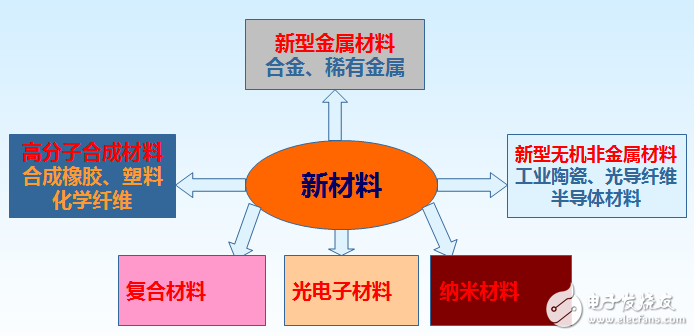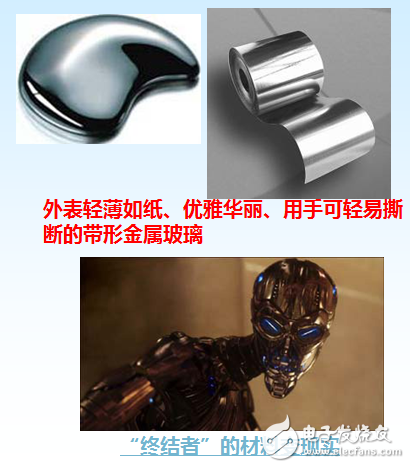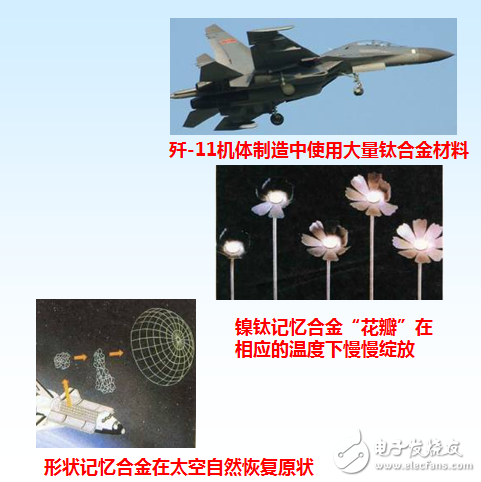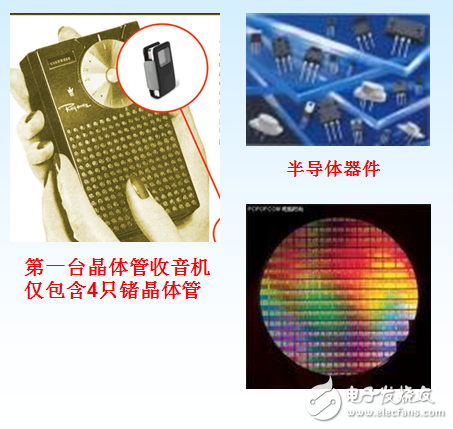Application of new materials
New materials and their characteristics
New material refers to a class of materials that have recently developed or have developed properties that are superior to traditional materials.
Features: high knowledge and technology intensity; close relationship with new technology and new technology; fast replacement; rapid changes in variety style.
Type of new material

First, new metal materials
Amorphous metal: also known as "metal glass", which is formed by boiling molten steel at a rate of 1 million kWh per second. Its internal structure undergoes a qualitative change, and the atoms change from ordered to disordered. Excellent physical and magnetic properties, chemical corrosion resistance and mechanical wear resistance. Traditional caliper milling and strong acid solution can help them in many fields such as communication, transportation, electronics, home appliances, and theft prevention.


Alloy materials: New alloy materials include many types, their properties vary, their applications vary, aluminum alloys, magnesium alloys, titanium alloys, iron-nickel-chromium and high-temperature alloys, rare metal alloys, etc.

Shape memory alloy: It can change the shape caused by human when the temperature value changes. When the temperature returns to a specific value, the shape will automatically return to the original state without any difference. The toughness is extremely strong, and it can be repeatedly deformed and restored 5 million times. Without fatigue fracture, it is widely used in large antennas for satellites, spacecraft and space stations, aircraft component joints, and orthopedics. Other new metal functional materials such as hydrogen storage alloys.
Superconducting metal material: A material that completely disappears under certain conditions and produces superconductivity. It has three basic characteristics: zero resistance, complete diamagnetism and strong current carrying capacity.
Application of superconducting technology: manufacturing magnetic superconducting magnets for magnetic confinement nuclear fusion reactions, large-capacity energy storage equipment, high-energy accelerators, superconducting Generators, power transmission and transportation vehicles. For example, in the United States, superconducting power transmission can save 10 billion US dollars of electricity every year; manufacturing ultra-high-speed computers and high-sensitivity detection equipment, communication equipment, and aerospace systems. For example, in 1989, Japan developed the world's first superconducting sub-computer, all of which use Josephson superconducting devices, with an operating speed of 1 billion times per second and a power consumption of 6.2 mW, which is only a thousandth of the power consumption of conventional electronic computers. one.

Second, polymer synthetic materials
The polymer is an organic compound having a sufficiently high molecular weight composed of elements such as carbon, hydrogen, oxygen, nitrogen, silicon, and sulfur. Commonly used polymer materials have molecular weights ranging from a few hundred to several million, and some can be as high as tens of millions.
Polymer materials mainly include plastics, fibers, rubber, films, adhesives and coatings. Synthetic plastics, synthetic fibers and synthetic rubber are called modern synthetic polymers.
Features of polymer materials: light weight, high elasticity, low strength, good toughness, viscoelasticity, abrasion resistance, good insulation, low thermal conductivity, heat resistance, corrosion resistance, and easy aging.
Synthetic plastics: Polyethylene, polystyrene, polyvinyl chloride, and polypropylene are the most common plastic materials in daily life, with a global output of around 100 million tons.
Transparent glass with good transparency (Acrylic)
"Plastic King" corrosion-resistant plastic PTFE
Polycarbonate, polyoxymethylene, polyimide, and polyurethane which are commonly used as foam plastics, etc. as engineering plastics.
Third, new inorganic non-metallic materials
Synthetic fiber: “six rayon†such as polyester, nylon, acrylic, vinylon, polypropylene, and chlorin
It can be used for spacesuit, super-hot and ultra-cold aramid 1313; aramid 1414 which can be used as aircraft wing and high-strength cable; polyimide fiber which can withstand 400 °C high temperature and negative 273 °C ultra-low temperature;
Fluorescent fiber that can be used as a human body device such as artificial blood vessels and cartilage;
Multi-color fiber that can be used as a new camouflage suit;
It can be used as synthetic paper, synthetic leather, high-reducing fiber for high-efficiency dust collector, composite fiber, colored fiber, network wire, fully deformed yarn, hygroscopic fiber and ion exchange fiber.
Synthetic rubber: The natural latex is vulcanized into a formable and elastic material to fill the shortage of natural rubber; it develops extremely fast.
Prospective development of butadiene rubber, isoprene rubber, ethylene propylene rubber, etc.
Silicone rubber and fluororubber can be deformed at minus 50 degrees and can withstand temperatures of 250 degrees. They are used to make certain parts of rockets, missiles and aircraft.
Ceramic materials: The strength, hardness, wear resistance, high temperature resistance and corrosion resistance of the new ceramics are greatly improved compared with traditional ceramics, especially in overcoming the problem of the achilles weakness of traditional ceramics.
New structural ceramics: oxide ceramics, nitride ceramics, carbide ceramics, silicide ceramics, boride ceramics, arsenide ceramics, cyanide ceramics, etc.
New functional ceramics: device ceramics, capacitor ceramics, piezoelectric ceramics, electrostrictive ceramics, pyroelectric ceramics, magnetic ceramics, semiconductor ceramics, conductive and superconducting ceramics, optical ceramics and sensitive ceramics.
Third, new inorganic non-metallic materials
Glass material: It has changed the characteristics of fragile and heat transfer of traditional glass materials, and developed new varieties with "specific functions" such as FRP, memory glass, chemically sensitive glass, super toughness reinforced glass, laser glass, bulletproof glass, Radiation protection glass, etc.
Optical fiber: The glass fiber made of extremely high purity has revolutionized modern communication technology and has been widely used in medical, remote sensing, and telemetry.
Optical fiber communication has the advantages of long transmission distance, good confidentiality, anti-interference, etc. One cable can transmit millions of telephones; it can transmit high-intensity laser;

Semiconductor materials: Important information materials developed in the 1940s. Through the research work in recent decades, the types of semiconductor materials are constantly updated, and the application fields are expanding, becoming the basis for the development of information technology.
é”—Materials do not require heating, low power consumption, high reliability, fast conversion speed, versatility and small size, replacing the tube
Silicon material has high mechanical strength, strong crystallinity, abundant reserves in nature, low cost, and can draw large-sized single crystals, making it the main semiconductor material in the field of electronic information industry.
Gallium arsenide is the second most important semiconductor electronic material after silicon because of its fast electron movement speed and electron emission and emission of light. It can be made into a transistor with faster speed and more functions. Strong computer (10 times)

Fourth, composite materials
The functional composite material generally consists of a functional body and a matrix. The matrix not only functions as a whole, but also can produce synergistic or enhanced functions, utilizing electrical and chemical properties of the material.
There are piezoelectric functional composites, absorbing and shielding functional composites (stealth materials), conductive functional composites, etc., which have broad development prospects.
5. Biological materials
Biomaterials, also known as bioengineering materials or biomedical materials, are alternative materials for organ defects, lesions or failures in human organisms, that is, human organ reconstituted materials.
Bioactive ceramics have been combined with bone and associated with soft tissue
Biochemical cement is used in the repair of bone defects, fixation of bone implant materials, and restoration of teeth.
Artificial organs have produced artificial heart, artificial liver, artificial kidney, artificial throat, artificial eyeball, artificial bone, artificial skin, artificial plasma and blood, etc.
It is expected to develop biocomposites with active induction that promote the regeneration of human tissues and organs.
Sixth, optoelectronic materials
The optoelectronics industry has sprung up. It includes optical communication, optical computing, laser processing, laser medical, laser printing, laser video, laser instruments, laser controlled thermonuclear reactions, laser separation isotope, laser guidance and many other aspects.
Exploring and developing new optoelectronic materials and producing high-performance, miniaturized and integrated optoelectronic devices has become the forefront of the entire optoelectronics technology field.
Optoelectronic information materials are the foundation and precursor of the entire optoelectronic technology. These include elimination and information acquisition materials, information transmission materials, information storage materials, and information processing and computing materials, among which are various types of optoelectronic semiconductor materials, various optical and film materials, and various liquid crystal display (LCD) materials.
Electronic paper
LG Philips, the world's second-largest LCD monitor manufacturer, announced that it has developed the world's first 4096-color "electronic paper."
“Electronic Paper†is an ultra-thin, ultra-light display. The 14-inch color display developed by LG Philips is as thin as paper and can be folded and bent at will. This "electronic paper" board is made of metal instead of the traditional glass, which increases product flexibility.
The "electronic paper" technology is different from the existing liquid crystal technology. "Electronic paper" has no strong reflection that cannot be avoided by other display devices at present, and the screen resolution is high, and the display effect and visual effect are almost the same as ordinary writing paper.
Seven, nano materials
Nanomaterials, also known as ultrafine particulate materials, consist of nanoparticles. Nanoparticles, also called ultrafine particles, generally refer to particles between 1 and 100 nm in size and are transitional regions at the junction of clusters and macroscopic objects.
From the usual micro and macro perspectives, such systems are not only typical microscopic systems but also atypical macroscopic systems. They are a typical human mesoscopic system with surface effects, small size effects, and macroscopic quantum tunneling effects.
Several typical nanomaterials
Nanoparticle material
Nanosolid material
Nanomembrane material
Nano magnetic liquid material
Carbon nanotube
Nanoparticulate materials: Also referred to as nanopowders, generally referred to as powders or granules having a particle size below 100 nm. It has new properties different from conventional solids due to its small size, large surface area and quantum size effect.
The nanosolid material generally refers to a compact solid material formed by pressing ultrafine particles having a size of less than 15 nm under high pressure or after a certain heat treatment process.
Nano magnetic liquid material: The magnetic liquid is an organic surfactant coated with a long bond of ultrafine particles, and is highly dispersed in a certain base liquid to form a stable magnetic liquid. It can move integrally under the action of an external magnetic field, and thus has magnetic control characteristics not found in other liquids.
Application of magnetic fluids:
Magnetic liquid static sealing device (safety valve)
The application of magnetic liquid on the speaker significantly improves the heat dissipation performance, increases the power by more than one time, automatically positions the voice coil, improves the frequency response, and reduces distortion.
Carbon nanotubes: A new member of the carbon material family, which is a black powder. It is a tubular material consisting of a hexagonal grid of carbon atoms like graphite. It is generally a multi-layer with a diameter of a few nanometers to several tens of nanometers. The length can be several microns or even a few millimeters.
The carbon nanotube itself has a very perfect structure, the size is only one hundred thousandth of the hair, but the conductivity is 10,000 times that of copper, the strength is 100 times that of steel and the weight is only one-seventh of steel. It is as hard as diamond, but it is flexible and stretchable. Its melting point is the highest among known materials.
If carbon nanotubes are used as ropes, it is the only rope that can be hung from the moon to the surface of the earth without being pulled by its own weight. If you use it to make an earth-moon ride, it is easy for people to settle on the moon.
The fine tip of the carbon nanotube is very easy to emit electrons. Used as an electron gun, it can be made into a wall-mounted TV screen with a thickness of several centimeters. This is the development direction of the TV manufacturing industry.
Application of nanomaterials
Due to the small size effect, surface effect, quantum size effect and macroscopic quantum tunneling effect of nanoparticles, they exhibit properties that are not available in conventional materials in terms of magnetism, light, electricity and sensitivity. Therefore, nanoparticles have broad application prospects in the sintering, catalysis, sensing, and ceramic toughening of magnetic materials, electronic materials, optical materials, and high-density materials.
Ceramic toughening: Nanoceramic materials made from nanoparticles are very tough. Because the nanomaterial has a large interface, the atomic arrangement of the interface is quite confusing, and the atom easily migrates under the condition of external force deformation, so it exhibits excellent toughness and ductility.
Optical applications: Nanoparticles have optical properties that are not available in conventional bulk materials due to small size effects, such as optical nonlinearity, light absorption, light reflection, and energy loss during optical transmission.
Various optical materials made using the special optical properties of nanoparticles will be widely used in daily life and high technology fields. At present, research on this aspect is still in the laboratory stage, and some have been promoted and applied.
Stealth material application: Since the size of nanoparticles is much smaller than the wavelength of infrared and radar waves, the transmittance of nano-particle materials to such waves is much stronger than conventional materials, which greatly reduces the reflectivity of waves, making infrared detectors and radars The received reflected signal becomes very weak, thus achieving stealth effect;
On the other hand, the specific surface area of ​​the nanoparticulate material is 3-4 orders of magnitude larger than that of the conventional coarse powder, and the absorption rate of infrared light and electromagnetic wave is much larger than that of the conventional material, which makes the reflected signal intensity of the infrared detector and the radar. Greatly reduced, so it is difficult to find the target being detected and play a stealth role.
Applications in Catalysis: Catalysts play a pivotal role in many chemical and chemical applications, controlling reaction time, increasing reaction efficiency and reaction rates.
Most of the conventional catalysts are not only low in catalytic efficiency, but also prepared by experience, which not only causes huge waste of raw materials for production, but also makes economic efficiency difficult to increase and pollutes the environment.
Nanoparticles have many surface active centers, which provide the necessary conditions for catalysts. By using nanoparticles as catalysts, the reaction efficiency can be greatly improved, the reaction rate can be controlled, and even the reaction which could not be carried out can be carried out. The reaction speed of the nanoparticles as a catalyst is 10 to 15 times higher than that of the general catalyst.
The role of environmental protection: With the quiet rise of nanotechnology, nano-environment will also come quickly, expand the ability of humans to use resources and protect the environment, and create conditions for thoroughly improving the environment and controlling new sources of pollution from the source.
Harmful gases: Nanotechnology can be used to make very good catalysts, and the sulfur content of petroleum catalyzed by it is less than 0.01%. Nano-sized combustion-supporting catalysts can be added to coal to help coal burn fully, improve energy utilization, and prevent the generation of harmful gases. The nano-scale catalyst is used in automobile exhaust gas catalysis, and has strong redox performance, so that sulfur dioxide and nitrogen oxides are no longer produced when gasoline is burned, and there is no need to carry out exhaust gas purification treatment at all.
Sewage treatment: The precious metals in the sewage are substances that are extremely harmful to the human body. It is lost from sewage and is a waste of resources. A new kind of nanotechnology can completely extract precious metals such as gold, strontium, palladium, platinum, etc. from sewage, and become a treasure. A new type of nano-scale water purifying agent has a strong adsorption capacity. Its adsorption capacity and flocculation ability are 10-20 times that of the ordinary water purifying agent aluminum trichloride.
Photocatalyst can degrade the main gaseous pollutants such as formaldehyde and methyl sting in the room. Among them, nano TIO2 (titanium dioxide, titanium dioxide) has the best degradation efficiency, reaching nearly 100%. Its degradation mechanism is to convert these harmful substances into carbon dioxide, water and organic acids under light conditions. The photocatalyst of nano TIO2 can also be used for industrial waste gas treatment in petroleum, chemical and other industries to improve the air quality around the plant.
Nano TIO2 can accelerate the degradation of municipal solid waste, which is more than 10 times faster than the large particle TIO2, thus solving the pressure brought by the large amount of domestic garbage to the urban environment.
The nanometer TiO2 catalytic degradation technology is used to treat the wool dyeing and finishing wastewater, which is rich in capital, high efficiency and energy saving, and finally can completely mineralize the organic matter without secondary pollution.
Self-cleaning effect: Due to its super-hydrophilic and super-lipophilic properties, nano-TiO2 has a self-cleaning effect on its surface, that is, its surface has the characteristics of anti-fouling, anti-fog, easy to wash and easy to dry. China has recently developed a "nano self-cleaning glass" with automatic cleaning function, which can automatically eliminate odor and sterilization.
“Nano-self-cleaning glass†is a high-tech nanotechnology coating a layer of nano-film on both sides of flat glass. Under the action of ultraviolet light, the film can decompose the dirt deposited on the glass, oxidize harmful gases in the room and kill the air. Various bacteria and viruses. The price ratio of this glass to ordinary glass is expected to be 1.5:1.
Nano leggings, knee pads, insoles
Nano far-infrared material with far-infrared health care function;
The use of nano-magnetic materials, combined with magnetic therapy;
It adopts nanometer permanent magnet material, no magnetic hard block, comfortable to wear and convenient to wash;
Effectively activates the metabolic capacity of cells and enhances body immunity;
Shujin active, improve local blood circulation, and relieve pain to joint pain quickly;
A full range of massage and stimulating effects on close skin;
The nano insole is made from a variety of nano-powders and has excellent deodorizing effect. Especially suitable for friends with a large amount of exercise, athlete's foot, ankles, do not have to clean, put it in the sun for a few minutes, the effect is better.
Anti-itch and anti-bacterial function Strong anti-moisture ability, inorganic antibacterial material in the product, can be long-lasting antibacterial, inhibit the proliferation of fungus in the shoe, prevent athlete's foot, athlete's foot and other diseases
Medical applications: The storage of drugs in carbon nanotubes, and through a certain mechanism to stimulate the release of the drug, the controllable agent promises to become a reality. Nanomaterial particles will make the drug transfer more convenient in the human body. Smart drugs wrapped with several layers of nanoparticles can actively search for and attack cancer cells or repair damaged tissues. New diagnostic tools that use nanotechnology can detect a variety of diseases through the proteins and DNA they need by detecting a small amount of blood.
The combination of nano-macromolecule "biological components" and small-molecule inorganic crystal structures, and nano-electronics control assembly into nano-robots will bring profound revolution to human medical science and technology, and many difficult diseases will be solved.
Home Appliances: Multi-material plastics made of nano-materials, which have antibacterial, deodorizing, anti-corrosion, anti-aging, anti-ultraviolet effects, etc., can be used as antibacterial deodorant plastics in refrigerators and air conditioner enclosures.
Computer and electronics industry: It is possible to read from hard disk readers and nano-material memory chips with a storage capacity of several thousand times that of current chips. After the widespread use of nanomaterials, computers can be reduced to "handheld computers."
Textile industry: Adding nano-SiO2, nano-ZnO and nano-SiO2 compound powder materials to synthetic fiber resin. After spinning and weaving, it can be used for underwear and clothing for sterilization, mildew proof, deodorization and anti-ultraviolet radiation. In the manufacture of antibacterial underwear and articles, functional fibers resistant to ultraviolet radiation that meet the requirements of the defense industry can be produced.
Mechanical industry: Nano-material technology is used to treat metal surface nano-powder coating on key mechanical parts, which can improve the wear resistance, hardness and service life of mechanical equipment.
The main task of the early 21st century was to design various new materials and devices based on various novel physical and chemical properties of nanomaterials. Modification of traditional products through nanomaterial science and technology, increasing its high-tech content and developing new products with nanostructures.
Nanomaterials will become a shining star in the field of materials science, playing a pivotal role in new materials, energy, information and other fields. With the continuous development of its preparation and modification technology, nanomaterials will be widely used in many fields such as fine chemicals and pharmaceutical production.
Fully understand the connotation of nanotechnology and promote the healthy development of nanotechnology in China.
Hydraulic Oil Pump Motor,Water Pump Motor,Voltage Induction Motor,High Tension Motor
Shaoxing AnFu Energy Equipment Co.Ltd , https://www.sxanfu.com